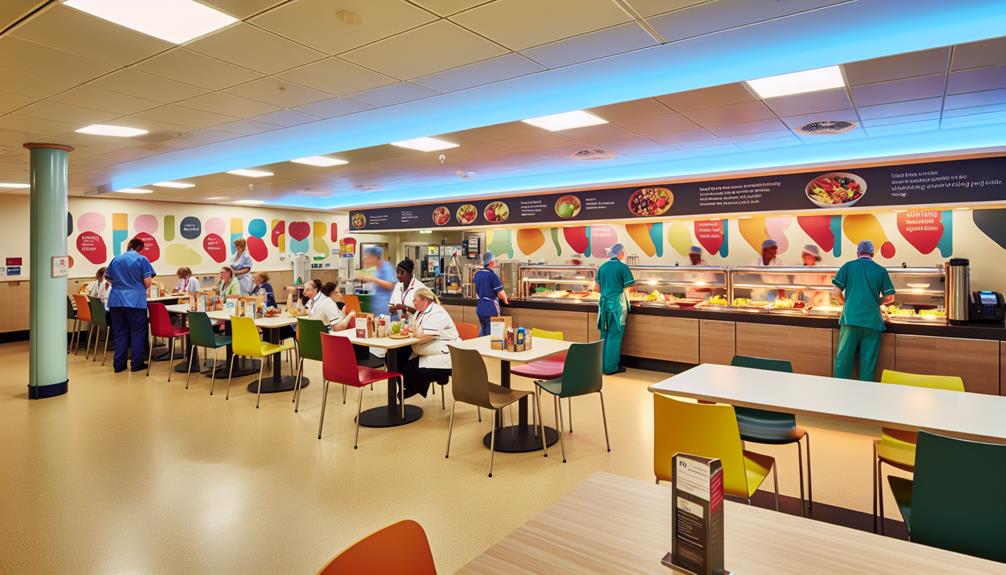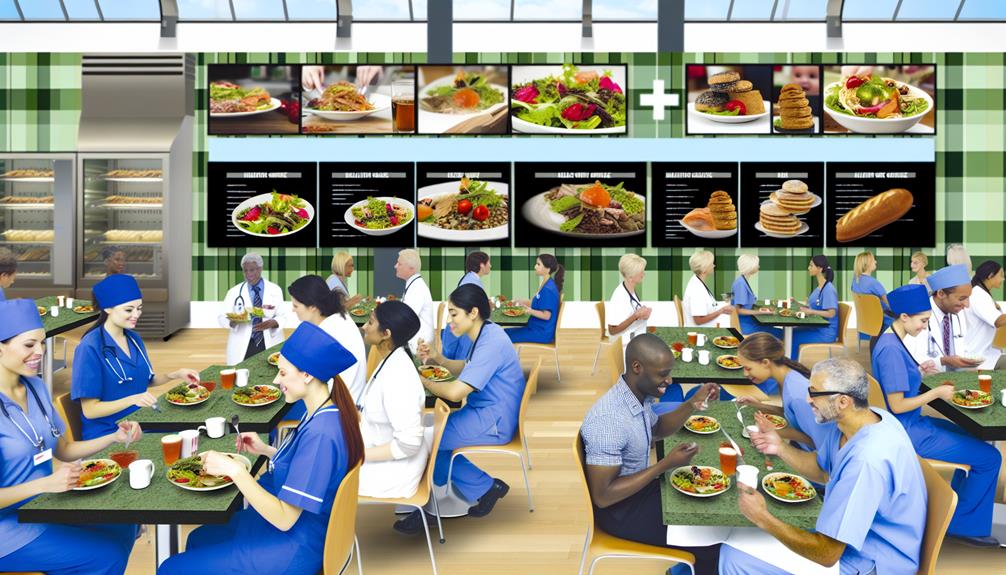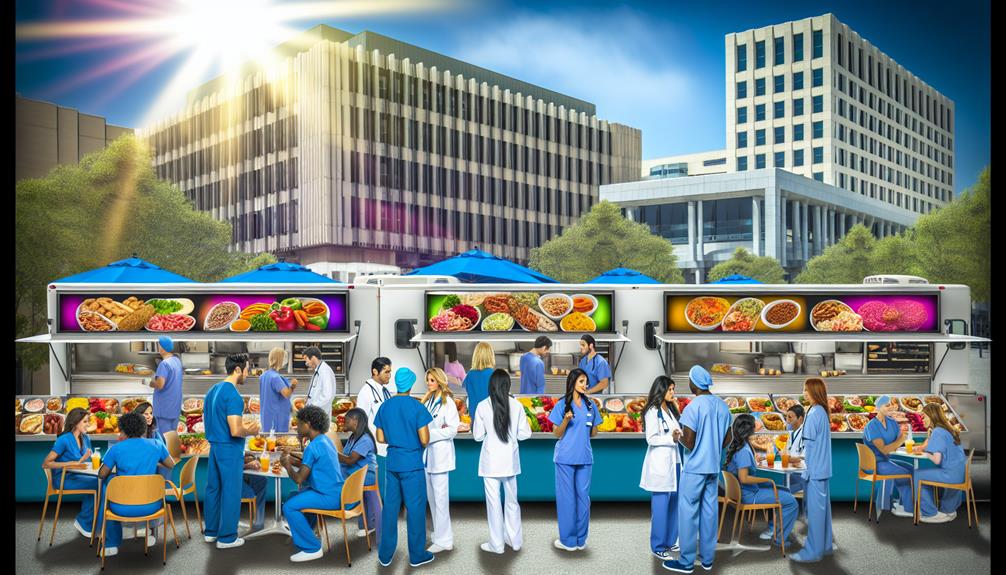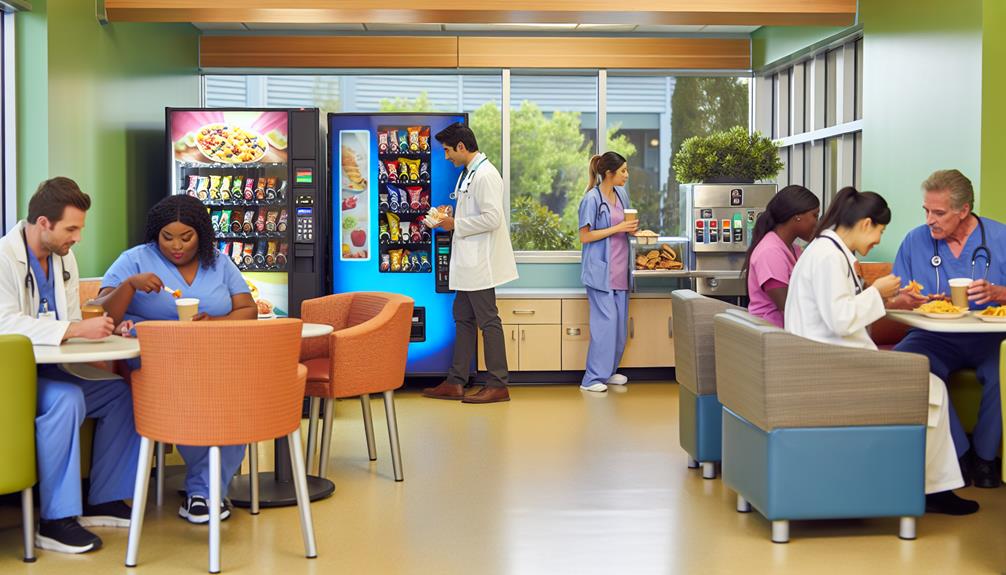Healthcare workers have several dining options that are shaped by hospital policies. Designated break rooms provide a communal space for relaxation and nourishment, featuring amenities to enhance comfort and health. On-site cafés and restaurants offer convenience, while employee discounts improve access to nutritious meals. Vending machines and snack stations cater to the need for quick nourishment, ensuring a variety of choices to accommodate diverse dietary preferences. Additionally, off-site dining options present flexibility for staff seeking different culinary experiences. Understanding these policies reveals how institutions prioritize employee well-being and satisfaction in their dining strategies.
Key Takeaways
- Healthcare workers can utilize designated break rooms equipped with seating, microwaves, and nutritious food options for relaxation and nourishment.
- On-site cafés and restaurants offer convenient meal choices, promote community, and provide employee discounts for affordable dining.
- Vending machines and snack stations supply quick, diverse, and healthier snack options to accommodate varying dietary needs during shifts.
- Off-site dining options allow flexibility and variety, enabling staff to explore local restaurants and food delivery services for diverse culinary experiences.
- Thoughtful dining policies, including meal reimbursement programs, enhance employee well-being and job satisfaction in high-stress environments.
Overview of Hospital Dining Policies

In many healthcare settings, dining policies greatly impact the well-being and efficiency of healthcare workers. These policies dictate where, when, and how employees can take their breaks to eat and drink, influencing not only their physical health but also their overall job satisfaction. Effective dining policies should consider meal reimbursement programs that alleviate financial burdens on staff, particularly in high-stress environments where time is limited. Additionally, providing options that promote relaxation, such as herbal teas like Sleepytime tea, can further support stress relief and improved sleep quality for workers after long shifts soothing effects of herbal tea.
Moreover, addressing dietary restrictions is vital to fostering an inclusive atmosphere. Healthcare workers often have varying nutritional needs due to medical conditions, ethical beliefs, or personal preferences. Policies must guarantee that accessible meal options cater to diverse dietary restrictions, thereby promoting a sense of belonging and community among staff.
In addition, the physical dining environment should be conducive to relaxation and social interaction, allowing workers to recharge during their shifts. By implementing thorough dining policies that prioritize meal reimbursement and accommodate dietary restrictions, healthcare facilities can enhance employee morale and retention. Ultimately, thoughtful dining policies contribute to a healthier workplace culture that values the needs of its workers.
Designated Break Rooms
Designated break rooms play an essential role in supporting the well-being and productivity of healthcare workers. These spaces are fundamental for fostering a sense of community and belonging among staff, allowing them to recharge during demanding shifts. The inclusion of adequate break room amenities, such as comfortable seating, microwaves, and refrigerators, enhances the overall experience, making it easier for employees to enjoy their meals and take necessary breaks. Additionally, having access to nutritious food options can greatly impact the energy levels and overall health of healthcare professionals, as navigating the grocery aisle can lead to healthier choices.
Furthermore, the effective management of food safety within these break rooms is imperative. Ensuring that all food items are stored properly and that the area is regularly sanitized contributes to a healthier work environment. Hospitals should implement guidelines that promote the safe handling of food, which not only protects the health of staff but also reflects the institution's commitment to overall wellness.
In addition to promoting health and safety, the presence of designated break rooms can reduce stress and increase job satisfaction. By providing a dedicated space where healthcare workers can unwind and connect with colleagues, hospitals acknowledge the importance of mental well-being in high-pressure environments. Consequently, investing in well-equipped break rooms is a strategic move towards enhancing staff morale and retention.
On-Site Cafés and Restaurants

The presence of on-site cafés and restaurants greatly enhances the dining experience for healthcare workers, complementing the benefits provided by designated break rooms. These facilities not only offer convenience but also foster a sense of community among staff members. By providing a space for informal interactions, on-site dining options can strengthen relationships and promote collaboration among healthcare professionals. In addition to this, similar to how high-quality ingredients matter in dog food, the selection of fresh and nutritious options in hospital dining can greatly impact employee well-being.
Furthermore, many hospitals implement employee meal discounts to encourage utilization of these dining facilities, making nutritious food more accessible and affordable. This initiative not only benefits employees financially but also supports healthier eating habits. On-site cafés and restaurants often adhere to established nutritional guidelines, ensuring that the meals served are balanced and conducive to the well-being of healthcare workers. By prioritizing nutrition, these establishments contribute greatly to the overall health and productivity of the staff.
Vending Machines and Snack Stations
Vending machines and snack stations play an essential role in providing quick and accessible nourishment for healthcare workers during their shifts. These facilities are particularly important in high-pressure environments where time constraints often limit the ability to take longer breaks. The vending machine variety available in many hospitals reflects an effort to cater to diverse dietary needs, offering options that range from healthy snacks to traditional comfort foods. For instance, incorporating items such as perfect chicken portions can provide a satisfying protein boost for on-the-go meals.
Snack station availability can further enhance the convenience for staff, providing a dedicated space to gather for brief respites. These stations often stock essential items like fruit, granola bars, and beverages, promoting healthier choices and encouraging hydration. The presence of these amenities underscores a commitment to employee well-being, acknowledging the demanding nature of healthcare work.
Moreover, well-stocked vending machines and snack stations can foster a sense of community among staff as they share a space designed for relaxation, even if briefly. To summarize, the integration of vending machines and snack stations into hospital policies is a critical component of supporting healthcare workers, offering them essential sustenance while acknowledging their unique challenges.
Off-Site Dining Options

Off-site dining options provide healthcare workers with additional flexibility and variety in their meal choices during shifts. Many hospitals are located in urban areas, where local restaurants and food delivery services are readily available. This can enhance the dining experience for healthcare professionals seeking nutritious meals that accommodate their busy schedules.
The following table highlights some popular off-site dining options for healthcare workers:
| Restaurant Name | Cuisine Type | Delivery Options |
|---|---|---|
| Green Plate | Vegetarian/Vegan | Yes (via Food Delivery) |
| Bella Italia | Italian | Yes (via Food Delivery) |
| Taco Haven | Mexican | Yes (via Food Delivery) |
| Asian Fusion | Asian | Limited (Pick-up Only) |
| The Daily Grind | Café/Breakfast | Yes (via Food Delivery) |
These options not only provide sustenance but also foster a sense of community, as healthcare workers can share recommendations or dine together outside the hospital. Utilizing local restaurants and food delivery services can enhance the overall well-being of healthcare professionals, allowing them to better manage their time and enjoy diverse culinary experiences.
Frequently Asked Questions
What Are the Meal Options for Night Shift Healthcare Workers?
Meal options for night shift healthcare workers often include pre-prepared meals and late night snacks that accommodate their unique schedules. Effective meal prep is essential, allowing individuals to have nutritious options readily available during their shifts. Common choices include whole grain wraps, salads, and protein-rich snacks such as nuts or yogurt. Establishing a routine for meal prep not only enhances health but also fosters a sense of community among colleagues who share similar challenges.
Can Healthcare Workers Bring Their Own Food to the Hospital?
Healthcare workers often wonder if they can bring their own food to hospitals, and policies typically permit this practice. However, guidelines regarding food storage and meal prep must be adhered to guarantee safety and hygiene. Hospitals may provide designated areas for storing personal meals, often requiring proper labeling and adherence to temperature controls. This flexibility allows healthcare professionals to maintain nutritional habits while accommodating their demanding schedules, fostering a sense of belonging through shared meal experiences.
Are There Any Dietary Accommodations for Staff Meals?
Dietary accommodations for staff meals are increasingly recognized as essential in fostering a supportive workplace environment. Many healthcare institutions offer meal customization options that cater to diverse staff dietary needs, including vegetarian, vegan, gluten-free, and allergen-free choices. These provisions not only enhance employee satisfaction but also promote well-being among healthcare workers. By addressing individual preferences and restrictions, organizations can demonstrate their commitment to inclusivity and health, ultimately benefiting staff morale and productivity.
How Often Are Hospital Dining Policies Reviewed or Updated?
Hospital dining policies are typically reviewed and updated on a regular basis, often annually or biannually, depending on the institution's procedures. This policy frequency guarantees that the guidelines remain relevant and responsive to the needs of healthcare workers and evolving nutritional standards. The review process typically involves stakeholder input, including feedback from staff, to foster a sense of belonging and inclusivity, ultimately enhancing the dining experience for all personnel involved.
Is There a Designated Area for Eating During Emergencies?
In emergency situations, designated areas for eating may be limited due to the urgency of responding to patient needs. Emergency protocols typically prioritize immediate care; consequently, staff breaks may be adjusted accordingly. Some healthcare facilities provide specific zones for meals during less critical periods, ensuring staff can recharge while remaining accessible. A balance between staff well-being and patient care is essential, fostering a supportive environment while adhering to operational demands during emergencies.



